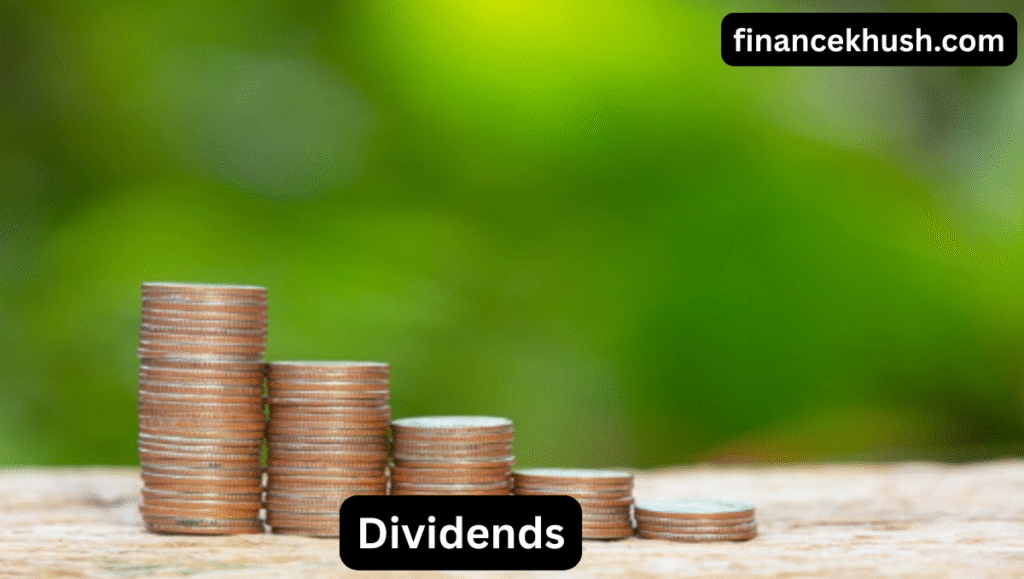Dividends are cash payments made by companies to their shareholders, typically as a reward for investing in the company. These payments provide a regular income stream and are especially appealing to those looking for passive income, such as retirees. While dividends can be a reliable source of income, they are not always guaranteed and can be reduced or eliminated during financial struggles. Understanding both the positive aspects, like stability, and the risks, such as potential cuts, is crucial for making informed investment decisions.
What Are Dividends?
A dividend is a payment made by a company to its shareholders, usually in the form of cash or additional shares of stock. Companies often distribute dividends as a way to share their profits with investors. For those who own stocks, dividends are one of the ways they can earn income from their investments, alongside potential capital gains (the increase in the stock’s price).
Dividends are typically paid out on a regular basis, such as quarterly, semi-annually, or annually. The company’s board of directors decides whether or not to issue a dividend, based on the company’s profitability and future financial plans.
How Do Dividends Work?
If you own shares of a company that pays dividends, you are entitled to receive a portion of the company’s profits. The amount of the dividend depends on the company’s performance and the number of shares you own. Here are a few key terms you might encounter when looking into dividends:
- Dividend Yield – This is the annual dividend income expressed as a percentage of the stock price. For example, if a stock pays a $1 dividend annually and is priced at $20 per share, the dividend yield would be 5% ($1 ÷ $20).
- Ex-Dividend Date – This is the date by which you need to own the stock in order to receive the upcoming dividend. If you buy a stock on or after the ex-dividend date, you won’t receive the dividend for that period.
- Payout Ratio – This is the percentage of a company’s earnings that is paid out as dividends. A high payout ratio may indicate that the company is returning a significant portion of its profits to shareholders.
- Dividend Aristocrats – These are companies that have consistently increased their dividends for 25 years or more. They are considered stable and reliable for income-seeking investors.
The Positive Side of Dividends
While investing in dividends isn’t always perfect, there are several reasons why they are a popular choice for many investors.
1. Steady Income Stream
For many investors, the main attraction of dividends is the potential for a steady income stream. Imagine getting paid regularly for holding onto your shares — it’s like getting a paycheck from your investments! This is especially appealing for retirees who are looking for reliable cash flow without having to sell their shares to access funds.
Dividend payments provide a passive income that can be reinvested or used to cover living expenses. This consistent source of income is one of the reasons why dividend-paying stocks are so attractive.

2. Compounding Power
Reinvesting your dividends can dramatically enhance your overall returns. Many investors choose to reinvest their dividends to buy more shares, which in turn generates more dividends, creating a snowball effect. Over time, this compounding can lead to significant wealth accumulation, even if you started with a small investment.
Let’s say you invest in a stock that pays a 5% annual dividend yield. If you reinvest those dividends instead of cashing them out, your total return could exceed the stock’s initial price appreciation alone. Over many years, reinvestment can make a huge difference.
3. Lower Risk for Investors
Dividend-paying stocks tend to be more stable than non-dividend-paying stocks, especially when the company is established and consistently generates profit. Companies that pay dividends usually have a history of profitability and are less likely to experience wild price swings compared to high-growth, non-dividend stocks.
Investors are often drawn to dividend-paying stocks during periods of market volatility because these stocks offer a cushion through regular dividend payments. In some cases, even if the stock price drops, the dividends can offset some of the losses.
4. Tax Advantages (In Some Cases)
In some countries, dividends are taxed at a lower rate than ordinary income, making them a tax-efficient way to earn money. For example, in the United States, qualified dividends are taxed at a lower rate than ordinary income, which can be beneficial for high-income earners.
5. Dividends Can Be Predictable
When companies establish a regular dividend payout schedule, investors have a better sense of when they will receive money. This predictability can be comforting for those who rely on their investments for regular income.
The Negative Side of Dividends
As much as dividends can be beneficial, they aren’t without their downsides. There are several risks and limitations to consider before diving into dividend-paying stocks.
1. Dividends Are Not Guaranteed
Just because a company has paid dividends in the past doesn’t mean it will continue to do so in the future. Dividends are subject to the company’s financial performance. If a company faces financial difficulties, it may reduce or even eliminate its dividend payments to conserve cash.
For example, during economic downturns or financial crises, many companies may cut their dividends to preserve capital. This is especially true for companies that are not financially sound or have high debt levels.
2. Dividend Stocks Can Be Less Growth-Oriented
Some of the most exciting and fastest-growing companies are those that reinvest all their profits back into the business to fuel expansion. Tech companies, for example, may not pay dividends, as they prefer to use their capital for research, development, and innovation.
Investors who prioritize growth may miss out on significant upside potential by focusing too much on dividends. In other words, if you’re looking for high growth, you might want to consider other types of stocks that don’t pay dividends but reinvest profits into the business.
3. Dividend Taxation
While dividends can have tax advantages in some cases, they can also be subject to taxation. In certain countries, dividend income is taxed at a higher rate than capital gains, which can eat into your profits. This is something to consider when choosing whether to invest in dividend-paying stocks.
4. Dividend Traps
Not all dividend-paying stocks are created equal. Some companies offer high dividend yields to attract investors, but these high payouts can sometimes be a red flag. A high dividend yield may indicate that a company is in trouble, and it might not be able to sustain those payouts in the future.
Investors should be cautious of “dividend traps” where companies are paying out unsustainable dividends in order to lure in investors. If a company is struggling financially, it might resort to borrowing money to fund dividends, which is not a good sign.
5. Impact of Inflation
While dividends offer a consistent source of income, they may not always keep pace with inflation. For example, if you’re relying on dividends to cover living expenses, you may find that your purchasing power decreases over time if the dividends don’t grow as quickly as inflation.
Even though many dividend-paying companies increase their dividends over time, there’s no guarantee that they will keep up with the rising cost of living.
How to Choose Dividend Stocks
Now that we’ve looked at both the positives and negatives of dividends, how can you make sure you’re choosing the right dividend-paying stocks? Here are a few tips:
- Look for Companies with a Strong History of Paying Dividends – Companies that have a long track record of paying and increasing dividends are more likely to continue doing so in the future.
- Check the Payout Ratio – A sustainable payout ratio (typically 30-60%) is a good sign that the company is not overextending itself to pay dividends.
- Consider Dividend Growth – Focus on companies that have consistently grown their dividend payouts. This shows a commitment to rewarding shareholders.
- Evaluate the Company’s Financial Health – Ensure that the company is financially stable and generating consistent cash flow. Avoid companies that are heavily reliant on debt to fund their dividends.

Conclusion
Dividends can be a fantastic way to earn passive income and build wealth over time, especially if you’re looking for stability and a predictable income stream. They come with a range of benefits, including steady cash flow, the power of compounding, and lower risk compared to non-dividend stocks.
However, they’re not without their downsides. Dividends are not guaranteed, and dividend-paying stocks may not provide the same growth potential as non-dividend-paying companies. Plus, taxes and inflation can reduce the benefits.
related post
Here are top 6 best faq’s
1. What Exactly Are Dividends?
Dividends are cash payments made by a company to its shareholders as a way to share part of its profits. Think of them as a reward for holding onto the company’s stock. Not all companies pay dividends, but those that do often distribute them on a regular schedule, like quarterly or annually. It’s like getting a little “thank you” for being an investor!
2. How Do I Know If A Stock Will Pay Dividends?
To find out if a stock pays dividends, you can check the company’s profile on any major stock market website, such as Yahoo Finance or Google Finance. These platforms will show you the dividend yield and payout schedule. Additionally, you’ll want to look for the “ex-dividend date,” which tells you the last day you can buy the stock and still receive the dividend for that period.
3. Can Dividends Be Increased Over Time?
Yes, dividends can increase over time, but it depends on the company’s performance and profitability. Many companies strive to raise their dividends regularly, especially those considered “Dividend Aristocrats” (companies that have increased dividends for 25 years or more). However, it’s not guaranteed — if a company faces financial challenges, it may reduce or stop paying dividends altogether.
4. Are Dividends Paid to All Investors Equally?
Not exactly. Dividends are paid based on how many shares you own, so if you own more shares, you’ll receive more dividend money. For example, if a company declares a $1 dividend per share and you own 100 shares, you’d receive $100. If you own just 10 shares, you’d get $10. The amount of the dividend is always per share, not a flat rate for every investor.
5. What Happens If A Company Cuts Its Dividends?
If a company reduces or stops its dividend payments, it can signal financial trouble or a shift in its business strategy. While it’s not always a disaster, it often causes concern for investors who rely on the income. It’s important to research why the dividend was cut — sometimes it’s to reinvest in the business, and other times it could be a sign of financial instability.
6. Should I Only Invest in Dividend Stocks for Steady Income?
Not necessarily. While dividend stocks can provide a steady income, they are not the only way to generate wealth. Dividend-paying stocks are great for investors seeking stable, regular returns, especially in retirement. But if you’re more focused on high growth or capital appreciation (the rise in stock value), you may want to also consider non-dividend-paying stocks. A balanced portfolio often includes both types depending on your goals.
